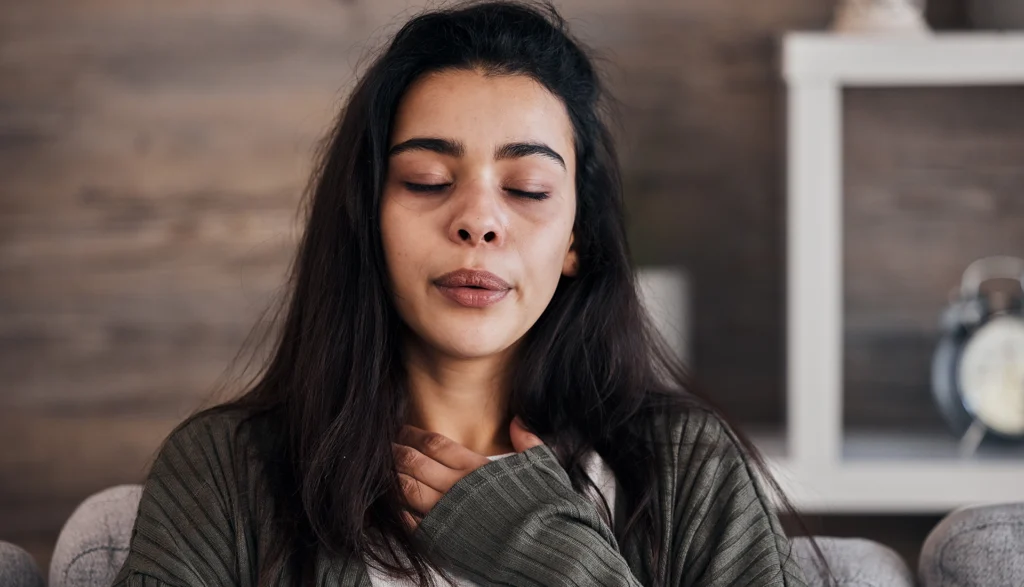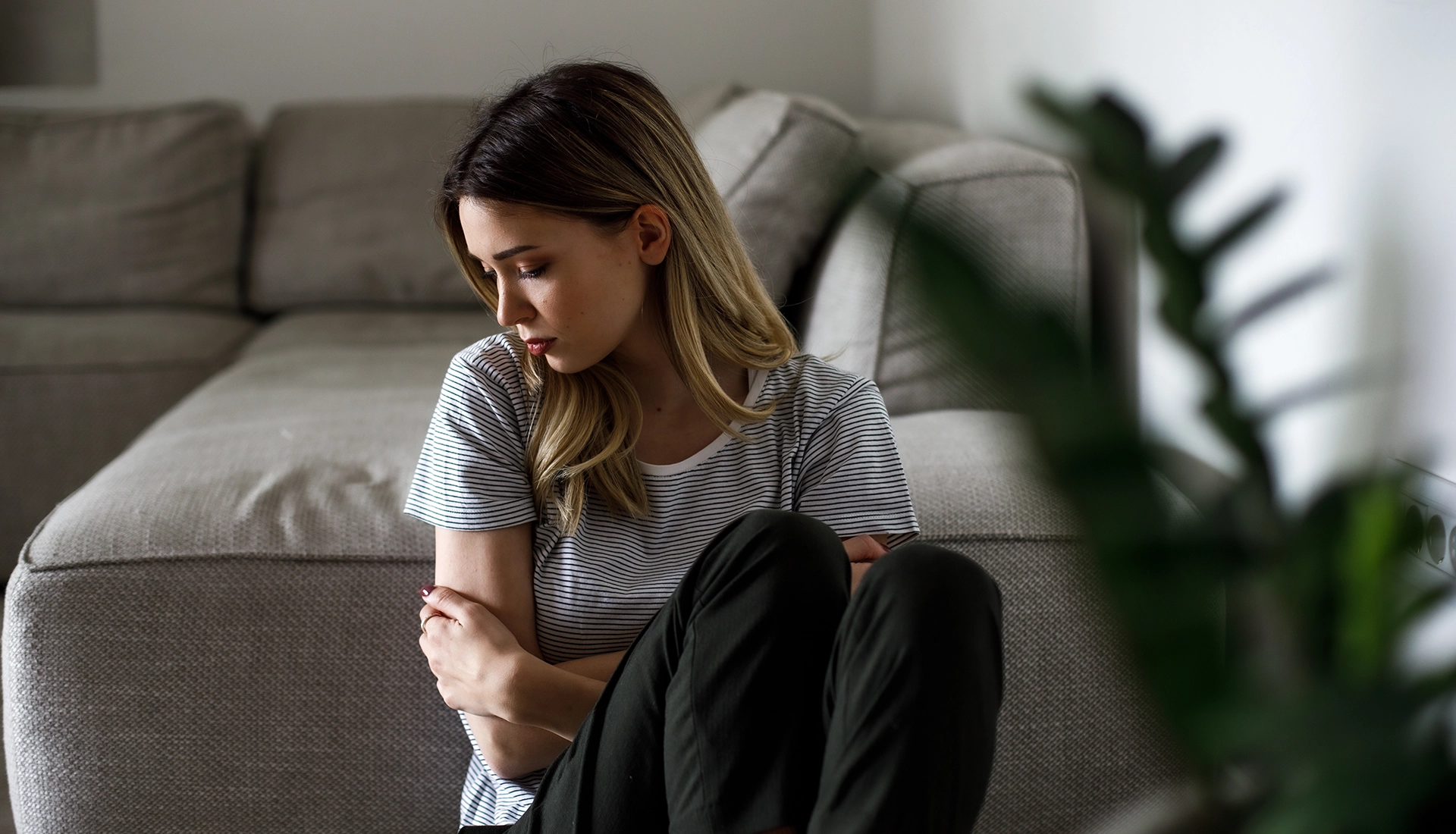Why is anxiety more common in women? This article examines the causes, symptoms, and treatments. Discover what makes anxiety in women unique and how to manage it.
Key Takeaways
- Women are over twice as likely to experience anxiety disorders compared to men due to biological, social, and psychological factors.
- The causes of anxiety in women include hormonal fluctuations, life stressors, and genetic predispositions, necessitating a comprehensive understanding for effective management.
- Common anxiety disorders in women include generalized anxiety disorder, panic disorder, and social anxiety disorder, each presenting distinct symptoms that require targeted treatment strategies.
Understanding Anxiety in Women
Anxiety is a feeling of worry, nervousness, or fear about an event or situation, but when these feelings become excessive anxiety and interfere with daily activities, they may indicate an anxiety disorder. Anxiety disorders happen to be the most common mental health conditions in the United States, affecting about 1 in 5 adults. Notably, women are more than twice as likely to experience anxiety disorders compared to men. This disparity can be attributed to a combination of biological, social, and psychological factors that uniquely impact women and contribute to various common mental disorders and mental illnesses that can trigger anxiety disorders, develop anxiety disorders, cause separation anxiety, and lead to mental health concerns.
Women are more susceptible to anxiety disorders partly due to hormonal fluctuations that can lead to mood disruptions. These hormonal changes, along with life events and stressors, play significant roles in triggering anxiety disorders in women. Moreover, women are more likely to experience specific phobias, such as animal phobias, and conditions like generalized anxiety disorder and panic disorder. The interplay of these factors makes understanding anxiety in women a complex but critical task.
Understanding the nuances of how anxiety manifests in women is essential for effective diagnosis and treatment. Anxiety disorders in women often present with a range of symptoms, including overwhelming worry, intense fear, and physical symptoms like muscle tension and heart palpitations. Early recognition of these symptoms and seeking appropriate treatment can significantly enhance the quality of life for women affected by anxiety disorders.
Causes of Anxiety in Women
The causes of anxiety in women are multifaceted, involving:
- Hormonal changes, which play a significant role in influencing women’s mental health and often trigger or exacerbate anxiety disorders.
- Life events and daily stressors, such as work-related stress and family responsibilities, which contribute significantly to the development of anxiety.
- Genetic and environmental factors.
The complexity of these factors underscores the need for a thorough understanding of what triggers anxiety disorders in women.
The interplay between hormonal changes and life events is particularly intricate. For instance, significant life changes such as pregnancy and the postpartum period can act as triggers for prenatal anxiety and anxiety disorders in women. Additionally, genetic predispositions and environmental influences can significantly elevate the risk of developing anxiety disorders. This comprehensive approach helps in identifying and managing the various factors that contribute to anxiety in women.
Hormonal Fluctuations
Sex hormones like estrogen and progesterone significantly influence mood regulation in women. Key periods of hormonal change that affect anxiety levels include:
- Puberty: Onset of ovarian hormone cycling with monthly fluctuations of estrogen and progesterone can exacerbate anxiety symptoms or trigger new anxiety issues, as these hormones interact with brain chemicals and stress hormones.
- Pregnancy: Significant increase in estrogen and progesterone, followed by a rapid drop after delivery, which can affect anxiety levels.
- Menopause: Another significant hormonal transition that can impact women’s mental health.
Panic disorder in women often correlates with significant hormonal changes, such as those occurring during the menstrual cycle. Women are generally more likely to report experiencing panic attacks than men, a phenomenon influenced by hormonal changes and anxiety sensitivity. Recognizing these hormonal influences is key to developing effective treatment strategies for anxiety disorders in women.
Life Events and Stressors
Significant life changes and daily stressors play a crucial role in the development of anxiety disorders in women. Key contributing factors include:
- Periods during and after pregnancy, identified as potential triggers for anxiety.
- The balancing act of managing work-related stress and family responsibilities, which often heightens anxiety levels.
- Fluctuations in estrogen levels during the menstrual cycle and reproductive years, contributing to anxiety disorders.
Daily stressors, including the pressure to perform in both personal and professional roles, can exacerbate anxiety symptoms. Women often find themselves juggling multiple responsibilities, which can lead to chronic stress and increased anxiety. Identifying these stressors and developing coping strategies is crucial for effective anxiety management.
Genetic and Environmental Factors
Genetic predispositions can significantly elevate the risk of developing anxiety disorders in women. Various environmental influences, such as stressors and life events, can act as triggers for anxiety disorders. When combined, these genetic and environmental factors can significantly increase the likelihood of anxiety disorders in women.
Recognizing these risk factors can assist in identifying individuals at higher risk and implementing preventive measures.
Common Types of Anxiety Disorders in Women
Women experience anxiety disorders more frequently than men, with lifetime prevalence rates about 1.5 to 2 times higher. Common anxiety disorders observed in women include generalized anxiety disorder, panic disorder, and specific phobias. These disorders often coexist with other anxiety disorders, such as major depressive disorder and bulimia nervosa. Recognizing the different types of anxiety disorders is essential for accurate diagnosis and treatment, particularly for most anxiety disorders.
Anxiety disorders in women often present with a range of symptoms, including overwhelming worry, intense fear, and physical symptoms like muscle tension and heart palpitations. Identifying these symptoms and understanding the specific type of anxiety disorder can assist in developing targeted treatment plans.
The following sections will delve deeper into the most common anxiety disorders affecting women.
Generalized Anxiety Disorder (GAD)
Generalized Anxiety Disorder (GAD) is characterized by persistent worry that disrupts daily activities. Women with GAD frequently experience issues like sleep disturbances and heightened irritability. The symptoms of GAD can significantly diminish the quality of life for women, affecting their emotional well-being and daily tasks. GAD may escalate following significant life changes or trauma, particularly in women.
GAD often leads to chronic anxiety, where excessive worry becomes a constant companion. This disorder can affect various aspects of life, from personal relationships to professional performance, and excessive anxiety interferes with recognizing the symptoms and triggers of GAD, which is vital for developing effective treatment strategies.
Panic Disorder
Panic disorder is characterized by recurrent and unexpected panic attacks, which can significantly impact women’s lives. Women are more likely to experience panic disorder due in part to anxiety sensitivity, cognitive factors, and neuroactive steroid fluctuations. The frequency of panic attacks increases for girls as they progress through puberty, particularly as they reach advanced Tanner stages.
Panic disorder can lead to severe anxiety, with symptoms including chest pain, rapid heart rate, and a sense of impending doom. These intense anxiety episodes, which may resemble a panic attack, can be debilitating, affecting daily activities and overall quality of life.
Recognizing the nature of panic disorder and its triggers is key for effective management and treatment.
Social Anxiety Disorder
Social anxiety disorder, with a lifetime prevalence of 5.67% in women, often manifests as heightened self-consciousness and fear of negative evaluation in social settings. Women with social phobia may avoid social interactions, leading to isolation and difficulties in forming and maintaining relationships.
The fear of social situations can significantly impair women’s personal and professional lives, affecting their self-esteem and overall well-being. Identifying the symptoms of social anxiety disorder and seeking appropriate treatment can help women manage their anxiety and enhance their quality of life.
Recognizing Symptoms of Anxiety in Women
Identifying the symptoms of anxiety in women is essential for early intervention and effective treatment. Anxiety disorders often present with a range of psychological and physical symptoms that can significantly impact daily life. Women experiencing anxiety disorders report heightened nervousness, a strong sense of impending doom, and difficulty concentrating. These anxious thoughts and behaviors can interfere with personal and professional relationships, leading to further stress and anxiety.
Fear and dread about current or future events are common experiences shared by women with anxiety disorders. Understanding these symptoms and recognizing their impact on daily life is the first step toward seeking help and managing anxiety effectively.
Psychological Symptoms
Women with anxiety may frequently experience:
- Feeling nervous, restless, or tense
- A sense of impending danger or doom, which is a common psychological symptom
- Difficulty concentrating or focusing on anything other than worries
- A persistent urge to avoid triggers that provoke anxious feelings
Physical symptoms such as trouble sleeping and fatigue frequently accompany the psychological manifestations of anxiety. Women may experience feelings of panic that can escalate to full-blown anxiety attacks. Identifying these psychological symptoms is crucial for early intervention and effective treatment.
Physical Symptoms
Muscle tension and pain are common physical symptoms associated with anxiety, often leading to fatigue. Rapid heart rate and palpitations are prevalent cardiovascular responses to anxiety experienced by women. Sweating and trembling, along with gastrointestinal issues like upset stomach and bloating, are common bodily responses to anxiety. These physical symptoms can significantly impact daily life and overall well-being.
Common physical symptoms of anxiety include:
- Muscle tension and pain, often leading to fatigue
- Rapid heart rate and palpitations, especially in women
- Sweating and trembling
- Gastrointestinal issues such as upset stomach and bloating
These physical symptoms can significantly impact daily life and can lead to serious complications and serious health problems and overall well-being.
Identifying the physical symptoms of anxiety is essential for effective diagnosis and treatment. Understanding how anxiety manifests in the body can help individuals seek appropriate medical and psychological support.

Diagnosing Anxiety Disorders in Women
Diagnosing anxiety disorders in women involves:
- A comprehensive review of the patient’s medical history and symptoms
- Using the DSM-5 guidelines, which provide criteria for diagnosing mental health conditions, including anxiety disorders
- A thorough assessment of symptoms, including physical examinations and standardized diagnostic tools
Combining psychotherapy and medication often yields the best outcomes for managing anxiety disorders. A detailed understanding of the patient’s past medical history can help identify co-occurring conditions and tailor the treatment plan accordingly.
Early and accurate diagnosis is critical for the effective treatment and management of anxiety disorders, as emphasized by the American Psychiatric Association.
Effective Treatment Options for Anxiety in Women
Anxiety disorders can result in significant impairment, with women often having higher rates of additional health care visits due to these conditions. Common treatment options for anxiety disorders in women include:
- Counseling
- Medicine
- Yoga
- Meditation Treatment at Back Bay Mental Health focuses on evidence-based therapies that empower women to effectively manage their anxiety.
The center provides an integrated approach that combines multiple therapeutic services, ensuring comprehensive support for women’s mental health needs. Personalized treatment plans and experienced clinicians, including a mental health provider, help women navigate their challenges effectively.
Recognizing the available treatment options is essential for successfully managing anxiety disorders.
Cognitive Behavioral Therapy (CBT)
Cognitive Behavioral Therapy (CBT) is a widely recommended treatment for anxiety disorders. CBT helps women change their thinking patterns and reactions to anxiety-inducing situations. This type of therapy, including talk therapy, focuses on identifying and challenging negative thoughts and beliefs, replacing them with more realistic and positive ones. Psychiatrists, psychologists, social workers, or counselors can provide CBT, making it accessible to many women seeking help.
CBT also involves the development of coping strategies and problem-solving skills to manage anxiety triggers effectively. Techniques such as exposure therapy, where individuals gradually face their fears in a controlled environment, can be particularly beneficial. Working with a trained mental health professional enables women to manage their anxiety and enhance their overall mental health.
Medication Management
Medication management is another crucial component of treating anxiety disorders in women. Several types of medications are commonly used, including:
- Anti-anxiety medications
- Selective serotonin reuptake inhibitors (SSRIs)
- Buspirone, a specific anti-anxiety medication that may be prescribed depending on the individual’s needs
- Benzodiazepines, which may be used for short-term management of severe anxiety symptoms.
Women should:
- Consult their doctor during pregnancy and breastfeeding to ensure the safety of pharmacotherapy for anxiety.
- Discuss any side effects with their doctor.
- Consult their doctor before stopping their medication.
A comprehensive treatment plan that includes medication management can significantly improve the quality of life for women who treat anxiety disorders.
Lifestyle Changes and Coping Strategies
In addition to therapy and medication, lifestyle changes and coping strategies are essential for managing anxiety effectively. Cognitive Behavioral Therapy (CBT) often focuses on developing coping strategies to deal with anxiety triggers. Exercise can significantly reduce anxiety levels and enhance overall mood, making it a crucial component of an anxiety management plan.
Maintaining a regular sleep schedule, avoiding stimulants like caffeine and nicotine, and incorporating relaxation techniques such as yoga and meditation can help ease anxiety symptoms.
Integrating these coping strategies with healthy lifestyle changes can significantly help manage anxiety and improve overall well-being.
How Back Bay Mental Health Can Help
Back Bay Mental Health offers an Intensive Outpatient Program (IOP) specifically tailored for women, designed to provide flexible and personalized mental health care. Their IOP allows clients to balance treatment with other life commitments, making it a practical option for many women. The facility is conveniently located near public transportation, ensuring easy access for those seeking mental health support.
The center provides comprehensive services to help women who struggle with anxiety through therapy and medication management. Their integrated approach combines multiple therapeutic services, ensuring that women receive the support they need to manage their anxiety effectively. Back Bay Mental Health’s experienced clinicians focus on empowering women to navigate their challenges and improve their mental health.
Understanding anxiety in women requires a comprehensive approach that considers the unique biological, social, and psychological factors involved. Hormonal fluctuations, life events, and genetic and environmental influences all contribute to the development of anxiety disorders in women. Recognizing the symptoms, both psychological and physical, is essential for early intervention and effective treatment.
Effective treatment options, including Cognitive Behavioral Therapy (CBT), medication management, and lifestyle changes, can significantly improve the quality of life for women with anxiety disorders. Back Bay Mental Health offers specialized programs and services to support women in managing their anxiety and achieving better mental health. By understanding and addressing the complexities of anxiety in women, we can empower those affected to seek help and take control of their mental health.
Frequently Asked Questions
What are the main causes of anxiety in women?
The primary causes of anxiety in women are hormonal fluctuations, significant life events and stressors, along with genetic and environmental influences. These factors collectively contribute to the onset and severity of anxiety disorders.
What types of anxiety disorders are most common in women?
The most common anxiety disorders in women are generalized anxiety disorder (GAD), panic disorder, and social anxiety disorder. Understanding these conditions can greatly aid in seeking appropriate support and treatment.
How can Cognitive Behavioral Therapy (CBT) help with anxiety?
Cognitive Behavioral Therapy (CBT) effectively assists individuals in altering their thought patterns and responses to anxiety-provoking situations, fostering the development of coping strategies and problem-solving skills to manage anxiety triggers. This structured approach empowers clients to tackle their anxiety head-on.
What should women consider when taking medication for anxiety?
Women should prioritize consulting their doctor when taking medication for anxiety, particularly during pregnancy and breastfeeding, and must discuss potential side effects. It is crucial to avoid stopping any medication without medical guidance.
How can lifestyle changes help manage anxiety?
Implementing lifestyle changes like regular exercise, a consistent sleep routine, and relaxation techniques can effectively manage anxiety and enhance overall well-being. Prioritizing these habits fosters a healthier mindset and reduces anxiety symptoms.




